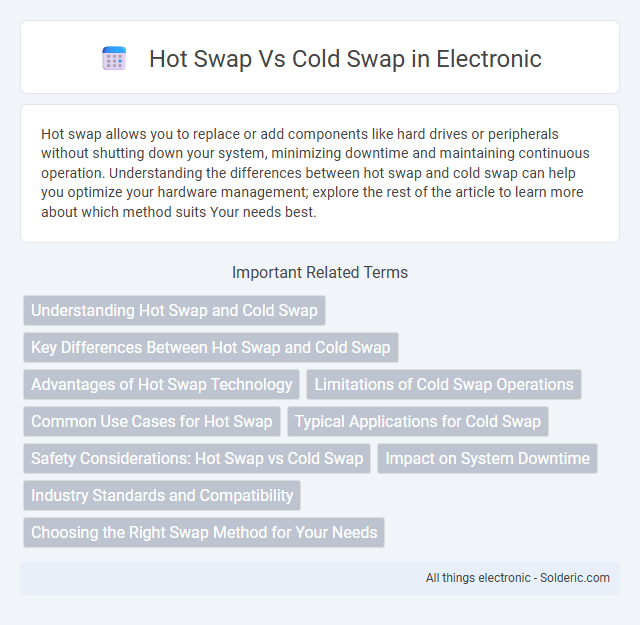Hot swap allows you to replace or add components like hard drives or peripherals without shutting down your system, minimizing downtime and maintaining continuous operation. Understanding the differences between hot swap and cold swap can help you optimize your hardware management; explore the rest of the article to learn more about which method suits Your needs best.
Comparison Table
| Feature | Hot Swap | Cold Swap |
|---|---|---|
| Definition | Replacing or adding components while the system is powered on | Replacing or adding components only when the system is powered off |
| System Downtime | No downtime; system remains operational | Requires system shutdown; causes downtime |
| Common Use Cases | Hard drives, power supplies, network cards in servers | Internal components like CPUs, RAM, or non-hot-swap hardware |
| Risk Factor | Moderate risk if procedures are not followed | Low risk as system is powered down |
| Hardware Support Required | Hardware and OS must support hot swapping | No special hardware support needed |
| Complexity | More complex; needs compatible hardware and software | Simple procedure; standard replacement process |
| Example Devices | Hot-swappable RAID drives, USB devices | Internal motherboard components, sealed batteries |
Understanding Hot Swap and Cold Swap
Hot swap allows you to replace or add hardware components like hard drives or peripherals while the system is powered on, minimizing downtime and maintaining continuous operation. Cold swap requires shutting down the device completely before removing or installing components, ensuring safety but causing temporary system unavailability. Understanding the differences between hot swap and cold swap helps you choose the best method for your hardware maintenance needs.
Key Differences Between Hot Swap and Cold Swap
Hot swap allows you to replace or add components like hard drives or CPUs without powering down the system, minimizing downtime and maintaining continuous operation. Cold swap requires powering off the system before replacing components, ensuring safety but causing interruptions in workflow. Understanding these key differences helps you choose the appropriate method based on your system's design and operational needs.
Advantages of Hot Swap Technology
Hot swap technology allows devices to be connected or disconnected without shutting down the entire system, significantly reducing downtime and enhancing operational efficiency. This capability enables seamless maintenance and upgrades, supporting continuous workflow in critical applications such as data centers and telecommunications. Moreover, hot swapping minimizes the risk of data loss and hardware damage by maintaining power and system stability during the replacement process.
Limitations of Cold Swap Operations
Cold swap operations require powering down the system before removing or replacing components, leading to significant downtime and productivity loss. This process risks hardware damage due to static discharge or improper handling during shutdown and restart cycles. Unlike hot swap, cold swap limits system availability and is unsuitable for environments demanding continuous operation or high uptime.
Common Use Cases for Hot Swap
Hot swap technology enables the replacement or addition of components such as hard drives, RAM modules, and network cards without shutting down the system, minimizing downtime in critical environments like data centers and enterprise servers. Common use cases for hot swap include upgrading storage arrays, maintaining live servers, and replacing faulty hardware in high-availability systems. This functionality ensures continuous operation and rapid hardware maintenance in mission-critical applications.
Typical Applications for Cold Swap
Cold swap is commonly used in applications where power must be completely disconnected before replacing or installing hardware components, such as internal computer parts, power supplies, or certain industrial equipment. This method ensures safety and prevents damage in systems that lack hot-swap capability, like traditional desktop PCs or legacy servers. Your equipment benefits from cold swapping in environments with strict power management and when installing components that do not support live replacement.
Safety Considerations: Hot Swap vs Cold Swap
Hot swap technology allows hardware components to be safely replaced or added while the system remains powered on, minimizing downtime but requiring careful adherence to device and system compatibility to prevent electrical damage or data loss. Cold swap involves powering down the system before replacing components, eliminating electrical risks and ensuring maximum safety but resulting in system downtime. Safety protocols for hot swap emphasize electrostatic discharge precautions and adherence to manufacturer guidelines, whereas cold swap prioritizes complete power disconnection to avoid hazards.
Impact on System Downtime
Hot swap technology allows you to replace or add components without powering down the system, significantly minimizing system downtime and maintaining continuous operations. In contrast, cold swap requires shutting down the system completely before making hardware changes, leading to longer downtime and potential disruption of services. Choosing hot swap-compatible devices is crucial for environments where uptime is critical and system availability cannot be compromised.
Industry Standards and Compatibility
Hot swap technology complies with industry standards such as PCI Express and SATA, enabling hardware components to be replaced or added without shutting down systems, enhancing uptime and operational efficiency. Cold swap requires adherence to standard shutdown and startup procedures defined by organizations like JEDEC and IEC to ensure hardware compatibility and prevent damage during power-off replacement. Compatibility considerations emphasize that hot-swappable devices must support live insertion and removal protocols, while cold-swappable components prioritize robust connectors and firmware reset mechanisms aligned with industry specifications.
Choosing the Right Swap Method for Your Needs
Choosing between hot swap and cold swap depends on your system requirements and operational priorities. Hot swap allows you to replace or add components without shutting down your device, minimizing downtime, which is ideal for mission-critical environments. Cold swap requires powering down the system to safely change hardware, providing a safer method for components that could be damaged by live removal or insertion.
Hot swap vs Cold swap Infographic

 solderic.com
solderic.com